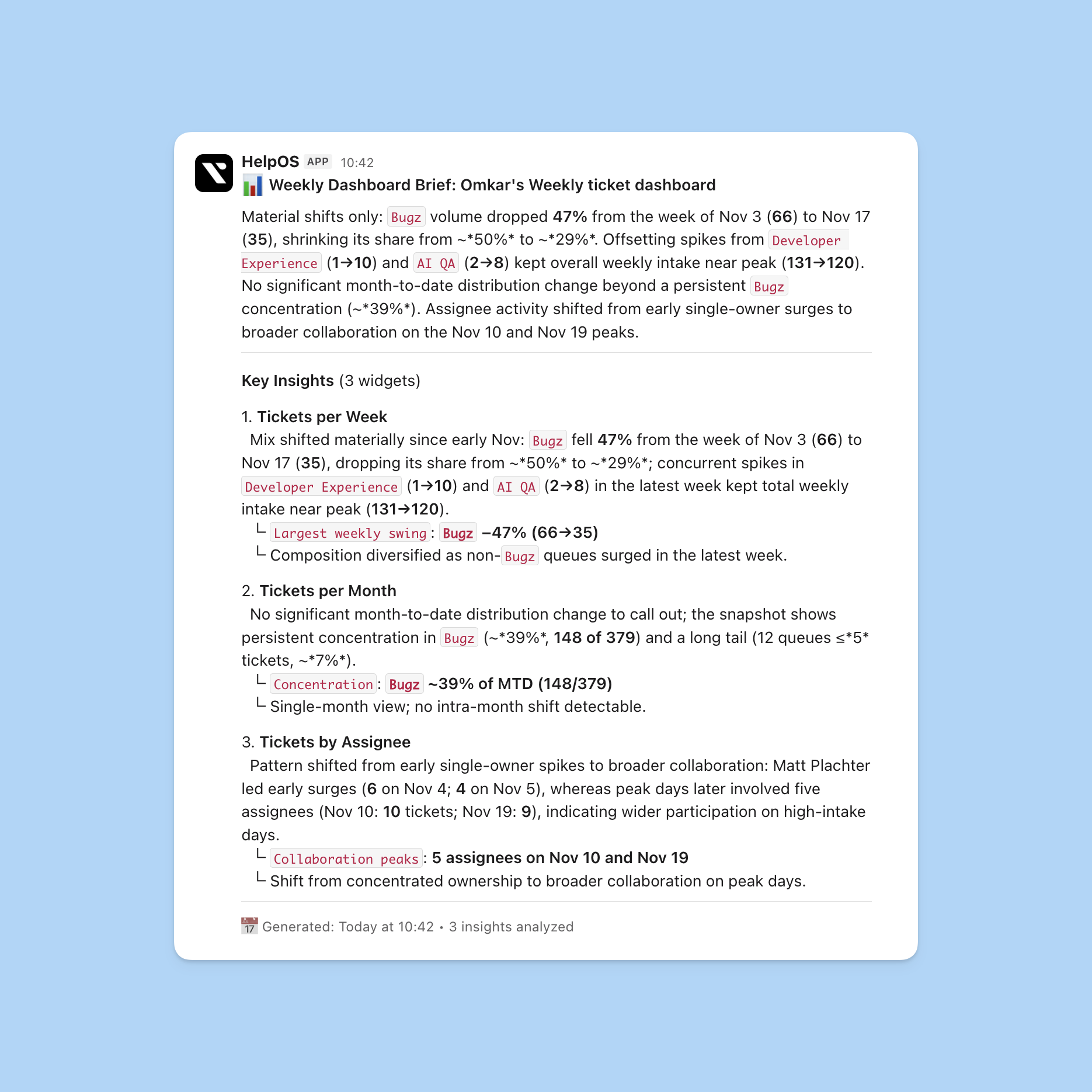
Setting up AI Briefs
1
Navigate to your custom dashboard
Navigate to any custom dashboard you’ve created in Analytics.
AI Briefs are only available for custom dashboards, not prepackaged system dashboards. You must have at least one custom dashboard with widgets to use this feature.
2
Access AI Brief settings
Click the AI Brief button in the dashboard header to open the configuration modal.


3
Configure delivery settings
Set up your delivery preferences including Slack channels, cadence, and custom instructions.
Configuration Options
Delivery Settings
Select one or more Slack channels where the AI brief will be delivered. You can send the same brief to multiple channels simultaneously.
The Ravenna bot must be a member of the selected channels to post the brief.
Choose how frequently the AI brief is generated and sent
Scheduling Options
Set the specific time when the brief will be sent, using 24-hour format in UTC timezone. For example,
09:00 for 9:00 AM UTC.Available for weekly cadence. Choose which day of the week the brief will be sent (Sunday through Saturday).
Available for monthly cadence. Choose which day of the month the brief will be sent (1st through 31st).
Content Customization
Optional custom instructions to guide the AI’s tone, focus, or format. Use this to tailor the brief for your specific audience or emphasize particular aspects of the data.
How AI Briefs Work
Content Generation Process
AI Briefs follow a sophisticated process to create meaningful summaries:- Widget Analysis: The system analyzes all widgets in your dashboard and generates insights for each one
- Data Synthesis: AI combines individual widget insights into a cohesive executive summary
- Custom Rewriting (Optional): If you provide a custom prompt, the AI rewrites the brief according to your specific instructions
- Slack Delivery: The formatted brief is sent to all specified Slack channels
Brief Structure
Each AI brief contains: Executive Summary: A 3-5 sentence overview highlighting key metrics and trends from across all dashboard widgets Widget Insights: Bullet points for each dashboard widget containing:- Widget name (automatically included)
- Key metrics and data points
- Notable trends or changes
- Top performing metric (when applicable)
Data Coverage
AI Briefs analyze:- All widgets within your custom dashboard
- Data based on the dashboard’s configured date range
- Key metrics, trends, and performance indicators
- Comparative analysis where relevant
Managing AI Briefs
Editing Schedules
To modify an existing AI brief schedule:- Navigate to the dashboard with an active AI brief
- Click the AI Brief button in the dashboard header
- Make your changes to timing, channels, or prompt
- Click Update to save changes
Deleting Schedules
To remove an AI brief schedule:- Open the AI brief configuration modal
- Click the trash icon in the form
- Confirm deletion
Best Practices
Prompt Optimization
- Be specific: Instead of “make it casual,” try “use a friendly tone appropriate for the customer success team”
- Focus on outcomes: Guide the AI toward actionable insights rather than just data recitation
- Consider your audience: Tailor language and emphasis for executives, operators, or technical teams
- Test and iterate: Refine your prompts based on the quality of generated briefs
Scheduling Considerations
- Time zones: All times are in UTC, so calculate the appropriate time for your team’s timezone
- Slack activity: Schedule briefs for times when your team is likely to see and act on them
- Data freshness: Ensure your dashboard’s date range captures the most relevant recent data
- Frequency balance: Choose a cadence that provides value without overwhelming recipients
Dashboard Setup
- Meaningful widgets: Include widgets that tell a complete story about your metrics
- Clear naming: Use descriptive widget names that will make sense in the brief context
- Appropriate date ranges: Configure dashboard date ranges that provide relevant insights for your cadence

